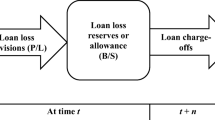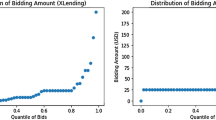Abstract
This research aims to investigate the moderating effect of information-seeking on the positive relationship between loan inclusion and Fintech P2P lending. It exploits how information-seeking plays an important role in the Fintech P2P loan decision. Unlike previous studies, we use primary data from 281 Fintech P2P borrowers to test the hypotheses. We use robust OLS regression and two-stage least square to estimate our model, and reveal three essential findings. First, loan inclusive (the individuals with traditional loan access) has lower Fintech P2P credit than the loan exclusive (those without traditional loan access). Second, information-seeking behavior would lower the Fintech P2P credit ratio. Lastly, information-seeking significantly moderates the relationship between loan inclusion and loans from Fintech P2P lending. It implies that those loan-exclusive individuals would have less Fintech P2P credit if they have high information-seeking.


Similar content being viewed by others
References
Aaker, D.A., and K.L. Keller. 1990. Consumer evaluations of brand extensions. Journal of Marketing 54 (1): 27–41.
Abbasi, K., A. Alam, N.A. Brohi, I.A. Brohi, and S. Nasim. 2021. P2P lending Fintechs and SMEs’ access to finance. Economics Letters 204: 109890.
Agarwal, S., Qian, W., and Tan, R. 2020. Financial inclusion and financial technology. In: Household Finance (pp. 307–346). Palgrave Macmillan, Singapore.
Bandura, A. 2006. Guide for constructing self-efficacy scales. Self-Efficacy Beliefs of Adolescents 5 (1): 307–337.
Bazarbash, M., Beaton, K., and Eriksson, U. 2020. Filling the gap: Digital credit and Financial Inclusion. IMF Working Papers, 2020(150).
Bronstein, J. 2014. The role of perceived self-efficacy in the information seeking behavior of library and information science students. The Journal of Academic Librarianship 40 (2): 101–106.
Burke, N. J., Bird, J. A., Clark, M. A., Rakowski, W., Guerra, C., Barker, J. C., and Pasick, R. J. 2009. Social and cultural meanings of self-efficacy. Health Education and Behavior, 36(5_suppl), 111S-128S.
Churchill, S.A., and V.B. Marisetty. 2020. Financial inclusion and poverty: A tale of forty-five thousand households. Applied Economics 52 (16): 1777–1788.
Clark, G.L., M. Fiaschetti, and P. Gerrans. 2019. Determinants of seeking advice within defined contribution retirement savings schemes. Accounting and Finance 59: 563–591.
Clark, M. 2017. Imposed-inquiry information-seeking self-efficacy and performance of college students: A review of the literature. The Journal of Academic Librarianship 43 (5): 417–422.
Cnaan, R. A., Scott, M. L., Heist, H. D., & Moodithaya, M. S. 2021. Financial inclusion in the digital banking age: Lessons from rural India. Journal of Social Policy, pp 1–22.
Daniels, K., and G.G. Ramirez. 2008. Information, credit risk, lender specialization and loan pricing: Evidence from the DIP financing market. Journal of Financial Services Research 34 (1): 35–59.
Darolia, R., and C. Harper. 2018. Information use and attention deferment in college student loan decisions: Evidence from a debt letter experiment. Educational Evaluation and Policy Analysis 40 (1): 129–150.
Dawson, J.F. 2014. Moderation in management research: What, why, when, and how. Journal of Business and Psychology 29 (1): 1–19.
De Freitas, N. E. M., and Legendre, B. 2015. Pension information and retirement planning in France: An evaluation of public policy. Netspar Discussion Paper No. DP 11/2015–072, Available at SSRN: https://ssrn.com/abstract=2744582 or http://dx.doi.org/https://doi.org/10.2139/ssrn.2744582
Dong, G. N. 2018. Informal bankruptcy: Health expenditure shocks and financial distress avoidance. Dong, GN (2018). Informal bankruptcy: Health expenditure shocks and financial distress avoidance. Financial Counseling and Planning, 29(1), 45–59.
Eid, N., and Yang, J. 2018. Online Financial Inclusion and Its Implications for Borrowers: Evidence From Peer-to-Peer Lending. Available at SSRN 3243499.
Fan, Y., J. Wu, and Z. Yang. 2017. Informal borrowing and home purchase: Evidence from urban China. Regional Science and Urban Economics 67: 108–118.
Flavián-Blanco, C., R. Gurrea-Sarasa, and C. Orús-Sanclemente. 2011. Analyzing the emotional outcomes of the online search behavior with search engines. Computers in Human Behavior 27 (1): 540–551.
Gaudecker, H.M.V. 2015. How does household portfolio diversification vary with financial sophistication and advice? The Journal of Finance 70 (2): 489–507.
Gielnik, M.M., R. Bledow, and M.S. Stark. 2020. A dynamic account of self-efficacy in entrepreneurship. Journal of Applied Psychology 105 (5): 487.
Hanafizadeh, P., and Amin, M. G. 2022. The transformative potential of banking service domains with the emergence of FinTechs. Journal of Financial Services Marketing, 1–37.
Hoffmann, A.O., and D. Plotkina. 2020. Why and when does financial information affect retirement planning intentions and which consumers are more likely to act on them? Journal of Business Research 117: 411–431.
Keilty, P., and G. Leazer. 2018. Feeling documents: Toward a phenomenology of information seeking. Journal of Documentation 74 (3): 462–489.
Kim, H., and J. Kim. 2010. Information search for retirement plans among financially distressed consumers. Journal of Family and Economic Issues 31 (1): 51–62.
Kurniasari, F., A. Gunardi, F. Putri, and A. Firmansyah. 2021. The role of financial technology to increase financial inclusion in Indonesia. International Journal of Data and Network Science 5 (3): 391–400.
Laha, A., and A. Sen. 2021. Relationship of financial inclusion and physical quality of life: Evidences from SAARC countries. International Journal of Economic Policy in Emerging Economies 14 (3): 248–268.
Lee, J., and J.M. Hogarth. 2000a. Consumer information search for home mortgages: Who, what, how much, and what else?☆. Financial Services Review 9 (3): 277–293.
Lee, J., and J.M. Hogarth. 2000b. Relationships among information search activities when shopping for a credit card. Journal of Consumer Affairs 34 (2): 330–360.
Liao, G., D. Yao, and Z. Hu. 2020. The spatial effect of the efficiency of regional financial resource allocation from the perspective of internet finance: Evidence from Chinese provinces. Emerging Markets Finance and Trade 56 (6): 1211–1223.
Lim, H., S. Heckman, C.P. Montalto, and J. Letkiewicz. 2014. Financial stress, self-efficacy, and financial help-seeking behavior of college students. Journal of Financial Counseling and Planning 25 (2): 148–160.
Llewellyn, D. T. (2021). Introduction: financial inclusion-an overview of key issues. Inclusive Financial Development, 1–12.
Lown, J.M. 2011. Development and validation of a financial self-efficacy scale. Journal of Financial Counseling and Planning 22 (2): 54–63.
Ma, S., Y.Y. Kor, and D. Seidl. 2020. CEO advice seeking: An integrative framework and future research agenda. Journal of Management 46 (6): 771–805.
Marsden, M., C.D. Zick, and R.N. Mayer. 2011. The value of seeking financial advice. Journal of Family and Economic Issues 32 (4): 625–643.
Maskara, P.K., E. Kuvvet, and G. Chen. 2021. The role of P2P platforms in enhancing financial inclusion in the United States: An analysis of peer-to-peer lending across the rural–urban divide. Financial Management 50 (3): 747–774.
Moenninghoff, S.C., and A. Wieandt. 2013. The future of peer-to-peer finance. Schmalenbachs Zeitschrift Für Betriebswirtschaftliche Forschung 65 (5): 466–487.
Nguyen, H.T. 2019. Development and validation of a women’s financial self-efficacy scale. Journal of Financial Counseling and Planning 30 (1): 142–154.
Ofori, E. (2020). The effects of Ponzi schemes and revocation of licences of some financial institutions on financial threat in Ghana. Journal of Financial Crime. Vol. ahead-of-print No. ahead-of-print. https://doi.org/10.1108/JFC-01-2020-0003
Oh, E. Y., and Rosenkranz, P. 2020. Determinants of peer-to-peer lending expansion: The roles of financial development and financial literacy. Asian Development Bank Economics Working Paper Series, 613)
Ozili, P.K. 2018. Impact of digital finance on financial inclusion and stability. Borsa Istanbul Review 18 (4): 329–340.
Pahlevan Sharif, S., and N. Naghavi. 2020. Family financial socialization, financial information seeking behavior and financial literacy among youth. Asia-Pacific Journal of Business Administration 12 (2): 163–181.
Pahlevan Sharif, S., A.S. Ahadzadeh, and J.J. Turner. 2020. Gender differences in financial literacy and financial behaviour among young adults: The role of parents and information seeking. Journal of Family and Economic Issues 41 (4): 672–690.
Park, J.H., B. Gu, A.C.M. Leung, and P. Konana. 2014. An investigation of information sharing and seeking behaviors in online investment communities. Computers in Human Behavior 31: 1–12.
Ren, B., L. Li, H. Zhao, and Y. Zhou. 2018. The financial exclusion in the development of digital finance—a study based on survey data in the Jingjinji rural area. The Singapore Economic Review 63 (01): 65–82.
Rhew, E., J.S. Piro, P. Goolkasian, and P. Cosentino. 2018. The effects of a growth mindset on self-efficacy and motivation. Cogent Education 5 (1): 1492337.
Rousset, M. M. V., Lambert, F., Torres, J., Herrera, L., Ramos, G., & Gershenson, M. D. (2021). Fintech and Financial Inclusion in Latin America and the Caribbean (No. 2021/221). International Monetary Fund.
Schmitt, J.B., C.A. Debbelt, and F.M. Schneider. 2018. Too much information? Predictors of information overload in the context of online news exposure. Information, Communication and Society 21 (8): 1151–1167.
Senyo, P. K., and Karanasios, S. 2020a. How do fintech firms address financial inclusion?. In International Conference on Information Systems, ICIS 2020a-Making Digital Inclusive: Blending the Local and the Global. Association for Information Systems.
Senyo, P. K., and Karanasios, S. 2020b. How do fintech firms address financial inclusion?. Working Paper. Association for Information Systems.
Stigler, G.J. 1961. The economics of information. Journal of Political Economy 69 (3): 213–225.
Suryono, R.R., B. Purwandari, and I. Budi. 2019. Peer to peer (P2P) lending problems and potential solutions: A systematic literature review. Procedia Computer Science 161: 204–214.
Thakor, A. V. (2020). Fintech and banking: What do we know?. Journal of Financial Intermediation, 41(C).
Tok, Y. W., and Heng, D. 2022. Fintech: Financial Inclusion or Exclusion?. Working Paper No. 2022/080. International Monetary Fund
Venet, B. 2019. FinTech and financial inclusion. In A Research Agenda for Financial Inclusion and Microfinance: Edward Elgar Publishing.
Wang, P., H. Zheng, D. Chen, and L. Ding. 2015. Exploring the critical factors influencing online lending intentions. Financial Innovation 1 (1): 1–11.
Wen, Y. 2018. Voluntary information acquisition in an asymmetric-Information game: Comparing learning theories in the laboratory. Journal of Economic Behavior and Organization 150: 202–219.
Yari Zanganeh, M., and N. Hariri. 2018. The role of emotional aspects in the information retrieval from the web. Online Information Review 42 (4): 520–534.
Younas, W., and K.R. Kalimuthu. 2021. Telecom microfinance banking versus commercial banking: A battle in the financial services sector. Journal of Financial Services Marketing 26 (2): 67–80.
Zhang, T., M. Tang, Y. Lu, and D. Dong. 2014. Trust building in online peer-to-peer lending. Journal of Global Information Technology Management 17 (4): 250–266.
Zhong, W., and T. Jiang. 2021. Can internet finance alleviate the exclusiveness of traditional finance? evidence from Chinese P2P lending markets. Finance Research Letters 40: 101731.
Funding
All authors have no relevant financial or non-financial interests to disclose.
Author information
Authors and Affiliations
Corresponding author
Ethics declarations
Conflict of interest
The author states that there is no conflict of interest.
Ethical approval
This article does not contain any studies with human participants or animals performed by the author.
Consent for publication
The author provides consent for publication if accepted.
Additional information
Publisher's Note
Springer Nature remains neutral with regard to jurisdictional claims in published maps and institutional affiliations.
Rights and permissions
About this article
Cite this article
Brahmana, R.K., Kontesa, M. & Yau, J.TH. Does information seeking moderate the relationship between financial loan inclusion and Fintech P2P lending?. J Financ Serv Mark 29, 171–185 (2024). https://doi.org/10.1057/s41264-022-00192-7
Received:
Revised:
Accepted:
Published:
Issue Date:
DOI: https://doi.org/10.1057/s41264-022-00192-7




